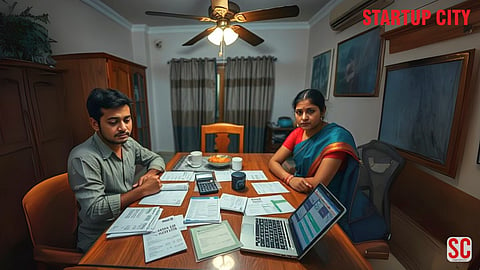

Somewhere between dreaming of a better future and surviving the present, the Indian middle class is fighting a silent battle. You won't see it on the evening news every day, but it’s there—in the choice between dining out or saving for a child's school fee, in the hesitation to refill a fuel tank completely, or in the stress of opening yet another utility bill.
Inflation, once a distant macroeconomic term for most, now lives in grocery bills, EMI notifications, and shrinking savings accounts. The middle class, often seen as India’s economic backbone, is struggling to hold its ground.
In many homes, conversations have shifted from what to upgrade to what to cut down. The problem isn’t just rising prices; it’s that incomes aren’t keeping pace. Data shows that real wages for salaried professionals have remained stagnant or dipped slightly, especially in urban India. Meanwhile, everyday expenses, from milk and onions to metro tickets and mobile data, have quietly crept up.
Take a moment to think about this: when was the last time you made a financial decision without checking your balance first? For most middle-class families, that kind of spontaneity is a thing of the past.
Let’s be honest, many of us are living on credit. Not because we’re careless, but because that’s the only way to stay afloat without compromising drastically on quality of life. Credit cards, EMIs, and Buy Now Pay Later schemes are filling the gaps that salaries can’t.
But here’s the red flag: household debt in India is at a record high, while savings are at a 50-year low. People are dipping into their fixed deposits, delaying insurance premiums, and taking personal loans just to maintain the life they built with so much effort.
A friend told me recently, “I haven’t bought anything new in six months, yet my credit card bill keeps rising.” That sentiment isn’t rare; it’s becoming the norm.
To adapt, families are turning toward smaller, cheaper options. Shampoo in sachets instead of bottles, two-wheeler fuel in ₹100 instalments, and smaller gift packs during festivals. This “pouch economy” isn’t a trend; it’s a coping mechanism.
Consumer companies are noticing this shift. Sales of high-value items have dipped, and brands are now focusing more on affordable packaging. Even automakers are reporting a slowdown in entry-level car purchases, a traditional middle-class milestone.
This isn’t just about economics; it’s about identity. When aspirations begin to shrink, a society feels it deeply.
Beneath the financial stress lies emotional fatigue. The constant need to budget, to deny wants, and to juggle responsibilities, it takes a toll. Parents worry about how to fund their children’s education. Young couples delay buying homes. Retirees dip into savings faster than they’d planned.
In counselling centres and financial helplines, there’s a sharp rise in people seeking help, not just for money management, but for anxiety caused by it.
To its credit, the government has taken some steps. The recent budget increased tax exemption limits, giving some relief. The RBI has cautiously lowered interest rates to reduce loan burdens. But for many, the help feels too little or too late.
While policymakers aim to stabilise inflation and encourage consumption, indirect taxes and service costs still hit the middle class hard. There’s a growing feeling that while the rich invest and the poor receive support, the middle class is left to fend for itself.
If you’re feeling the crunch, here’s the truth: you’re not alone. And there are things we can do.
Track your spending, not just big purchases but also small leaks that drain savings.
Avoid high-interest debt wherever possible. Credit cards may feel like lifelines but can quickly become traps.
Rebuild an emergency fund; even a modest one offers breathing room.
Talk openly with family about money. Financial stress shouldn’t be a solitary burden.
Seek help, whether it’s a financial advisor, a bank manager, or a counsellor.
At a larger level, it’s time for governments and corporates to re-examine how they serve this segment. Tax policies, social support systems, and workplace compensation structures need to be aligned with the realities the middle class lives with today.
The middle class built modern India. Its savings drove investment. Its spending fueled businesses. Its values shaped society. And now, it deserves to be protected, not just through policies, but through recognition of its importance and the challenges it faces.
This isn’t just about inflation. It’s about dignity, security, and hope.
So the next time you adjust your lifestyle to “manage better,” remember, this isn’t failure. It’s resilience. And even in these trying times, that’s worth a lot.